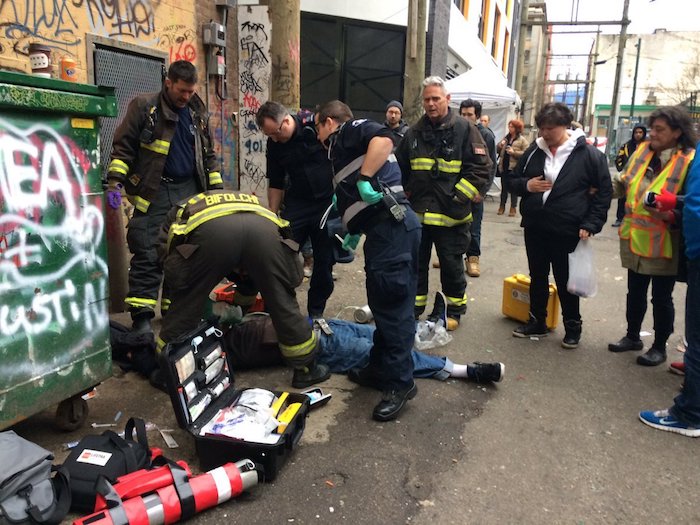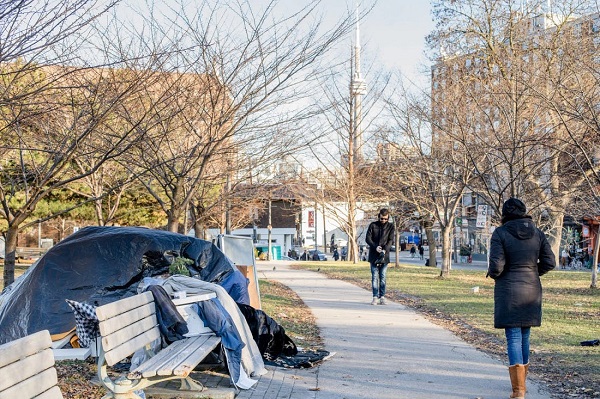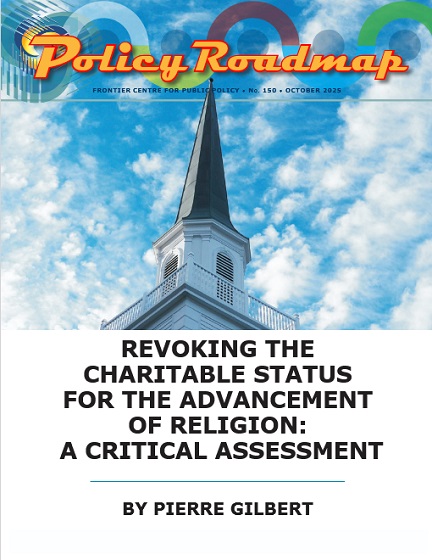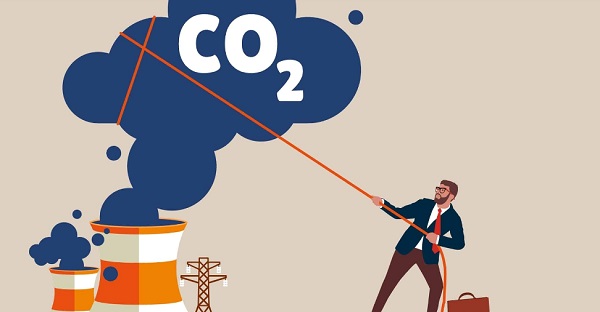Addictions
B.C. officials push back against safe supply critics and their ‘polarizing rhetoric’
Provincial health officer Dr. Bonnie Henry looks on as chief coroner Lisa Lapointe discusses details about the province’s application for decriminalization in the next step to reduce toxic drug deaths during a news conference in the press gallery at the legislature in Victoria, Monday, Nov. 1, 2021. THE CANADIAN PRESS/Chad Hipolito
Victoria
British Columbia officials have sought to rebut claims that drugs prescribed through the province’s safe supply program aimed at curbing overdoses are being re-sold to young people, helping fuel the deadly drug toxicity crisis.
B.C.’s representative for children and youth, Jennifer Charlesworth, said her office reviews injury and death reports involving young people and she hasn’t seen any sign that youth are either using drugs “diverted” from the safe supply program, or that they are suffering overdoses from such drugs.
Instead, she said “polarizing rhetoric” on the issue was causing harm.
“Safe supply is an alternative to the poison that is available on the street, and I’ll repeat, for emphasis, what I said earlier: there’s no indication from our data that diverted safe supply is causing overdoses for children and youth,” she said.
“Is it possible that diversion will be an issue in the future? Anything is possible within this highly complex and fast-evolving crisis we are all in.”
Her remarks came after Opposition Leader Pierre Poilievre recently told the House of Commons that federal and B.C. government policies are worsening the overdose crisis because prescription hydromorphone “gets sold to kids” by those taking part in the program, with the profits used to buy stronger substances, such as fentanyl.
B.C.’s chief coroner, Lisa Lapointe — who joined Charlesworth and provincial health officer Dr. Bonnie Henry at a news conference on Monday — said toxicology tests show hydromorphone hasn’t been present in any significant number of deaths.
Officials are “closely monitoring, continually, for any and all trends that may impact public safety” as a result of the safe supply program, she said.
Henry said monitoring has not detected an increase in opioid overdoses involving children, or new diagnoses of opioid use disorder.
She said the amount of hydromorphone being prescribed through the safe supply program is very small, and the drug has been available in large quantities through other routes for a long time.
Even if all of the hydromorphone prescribed as safe supply made its way to the street, “it would be a very, very tiny percentage of what is out there,” she said.
Asked to comment, a spokesman for Poilievre shared links to recent media stories, saying they “directly challenge” the “allegations” made by the B.C. officials.
The three officials expressed concern over the “polarization” of safe supply and other harm-reduction measures.
Charlesworth told the news conference they were “standing together, saying fear-based, polarizing rhetoric that is not evidence-informed is causing harm.”
Lapointe said it was not a response to any one person or media report, but they’ve been concerned about “increasingly polarized rhetoric that is not informed by evidence.”
She said recent “divisive” language and rhetoric surrounding people who use drugs drives them further underground, and that includes children and youth.
“If they’re using drugs, they will not come forward, or your relatives or your neighbours, and that is the most harmful thing we can do,” she said.
Asked about safeguards to ensure prescribed drugs are not being resold, Lapointe said drug trafficking remains a crime.
Officials are “dealing with a lot of anecdotal information and allegations,” she said.
Henry said officials can’t change policies based on “individual stories or anecdotes.”
“We need to have the data behind it.”
Still, Henry said she wanted the public to know that officials take concerning reports from clinicians, media and others seriously, and they investigate accordingly.
“We are not just doing this without having robust monitoring and evaluation.”
Henry said it may be time to re-evaluate the safe supply program to ensure it’s meeting people’s needs as the province emerges from the COVID-19 pandemic, which has contributed to increases in drug toxicity and overdose deaths.
She said she’s heard from some clinicians that hydromorphone isn’t always meeting patients’ needs, and may be used to acquire other substances.
“What we’re also hearing from people who use drugs is that sometimes they use (hydromorphone) as a commodity for friends, for others, who don’t have access.”
Officials will review early evidence from the program to consider any adjustments over the coming weeks and months, Henry said.
More than 12,400 people have died from overdoses since the B.C. government declared a health emergency in 2016.
Lapointe said it’s estimated that more than 100,000 people in B.C. have an opioid use disorder, a number that does not include people who use illicit opioids occasionally, or those who regularly or irregularly use stimulants.
“All of those tens of thousands of people are currently at risk of death or serious harm. A substantial, co-ordinated, comprehensive response is required.”
— By Brenna Owen in Vancouver
This report by The Canadian Press was first published June 5, 2023.
Addictions
BC premier admits decriminalizing drugs was ‘not the right policy’

From LifeSiteNews
Premier David Eby acknowledged that British Columbia’s liberal policy on hard drugs ‘became was a permissive structure that … resulted in really unhappy consequences.’
The Premier of Canada’s most drug-permissive province admitted that allowing the decriminalization of hard drugs in British Columbia via a federal pilot program was a mistake.
Speaking at a luncheon organized by the Urban Development Institute last week in Vancouver, British Columbia, Premier David Eby said, “I was wrong … it was not the right policy.”
Eby said that allowing hard drug users not to be fined for possession was “not the right policy.
“What it became was a permissive structure that … resulted in really unhappy consequences,” he noted, as captured by Western Standard’s Jarryd Jäger.
LifeSiteNews reported that the British Columbia government decided to stop a so-called “safe supply” free drug program in light of a report revealing many of the hard drugs distributed via pharmacies were resold on the black market.
Last year, the Liberal government was forced to end a three-year drug decriminalizing experiment, the brainchild of former Prime Minister Justin Trudeau’s government, in British Columbia that allowed people to have small amounts of cocaine and other hard drugs. However, public complaints about social disorder went through the roof during the experiment.
This is not the first time that Eby has admitted he was wrong.
Trudeau’s loose drug initiatives were deemed such a disaster in British Columbia that Eby’s government asked Trudeau to re-criminalize narcotic use in public spaces, a request that was granted.
Records show that the Liberal government has spent approximately $820 million from 2017 to 2022 on its Canadian Drugs and Substances Strategy. However, even Canada’s own Department of Health in a 2023 report admitted that the Liberals’ drug program only had “minimal” results.
Official figures show that overdoses went up during the decriminalization trial, with 3,313 deaths over 15 months, compared with 2,843 in the same time frame before drugs were temporarily legalized.
Addictions
Canada must make public order a priority again

A Toronto park
Public disorder has cities crying out for help. The solution cannot simply be to expand our public institutions’ crisis services
[This editorial was originally published by Canadian Affairs and has been republished with permission]
This week, Canada’s largest public transit system, the Toronto Transit Commission, announced it would be stationing crisis worker teams directly on subway platforms to improve public safety.
Last week, Canada’s largest library, the Toronto Public Library, announced it would be increasing the number of branches that offer crisis and social support services. This builds on a 2023 pilot project between the library and Toronto’s Gerstein Crisis Centre to service people experiencing mental health, substance abuse and other issues.
The move “only made sense,” Amanda French, the manager of social development at Toronto Public Library, told CBC.
Does it, though?
Over the past decade, public institutions — our libraries, parks, transit systems, hospitals and city centres — have steadily increased the resources they devote to servicing the homeless, mentally ill and drug addicted. In many cases, this has come at the expense of serving the groups these spaces were intended to serve.
For some communities, it is all becoming too much.
Recently, some cities have taken the extraordinary step of calling states of emergency over the public disorder in their communities. This September, both Barrie, Ont. and Smithers, B.C. did so, citing the public disorder caused by open drug use, encampments, theft and violence.
In June, Williams Lake, B.C., did the same. It was planning to “bring in an 11 p.m. curfew and was exploring involuntary detention when the province directed an expert task force to enter the city,” The Globe and Mail reported last week.
These cries for help — which Canadian Affairs has also reported on in Toronto, Ottawa and Nanaimo — must be taken seriously. The solution cannot simply be more of the same — to further expand public institutions’ crisis services while neglecting their core purposes and clientele.
Canada must make public order a priority again.
Without public order, Canadians will increasingly cease to patronize the public institutions that make communities welcoming and vibrant. Businesses will increasingly close up shop in city centres. This will accelerate community decline, creating a vicious downward spiral.
We do not pretend to have the answers for how best to restore public order while also addressing the very real needs of individuals struggling with homelessness, mental illness and addiction.
But we can offer a few observations.
First, Canadians must be willing to critically examine our policies.
Harm-reduction policies — which correlate with the rise of public disorder — should be at the top of the list.
The aim of these policies is to reduce the harms associated with drug use, such as overdose or infection. They were intended to be introduced alongside investments in other social supports, such as recovery.
But unlike Portugal, which prioritized treatment alongside harm reduction, Canada failed to make these investments. For this and other reasons, many experts now say our harm-reduction policies are not working.
“Many of my addiction medicine colleagues have stopped prescribing ‘safe supply’ hydromorphone to their patients because of the high rates of diversion … and lack of efficacy in stabilizing the substance use disorder (sometimes worsening it),” Dr. Launette Rieb, a clinical associate professor at the University of British Columbia and addiction medicine specialist recently told Canadian Affairs.
Yet, despite such damning claims, some Canadians remain closed to the possibility that these policies may need to change. Worse, some foster a climate that penalizes dissent.
“Many doctors who initially supported ‘safe supply’ no longer provide it but do not wish to talk about it publicly for fear of reprisals,” Rieb said.
Second, Canadians must look abroad — well beyond the United States — for policy alternatives.
As The Globe and Mail reported in August, Canada and the U.S. have been far harder hit by the drug crisis than European countries.
The article points to a host of potential factors, spanning everything from doctors’ prescribing practices to drug trade flows to drug laws and enforcement.
For example, unlike Canada, most of Europe has not legalized cannabis, the article says. European countries also enforce their drug laws more rigorously.
“According to the UN, Europe arrests, prosecutes and convicts people for drug-related offences at a much higher rate than that of the Americas,” it says.
Addiction treatment rates also vary.
“According to the latest data from the UN, 28 per cent of people with drug use disorders in Europe received treatment. In contrast, only 9 per cent of those with drug use disorders in the Americas received treatment.”
And then there is harm reduction. No other country went “whole hog” on harm reduction the way Canada did, one professor told The Globe.
If we want public order, we should look to the countries that are orderly and identify what makes them different — in a good way.
There is no shame in copying good policies. There should be shame in sticking with failed ones due to ideology.
Our content is always free – but if you want to help us commission more high-quality journalism,
consider getting a voluntary paid subscription.
-

 Energy2 days ago
Energy2 days agoIndigenous Communities Support Pipelines, Why No One Talks About That
-

 Alberta2 days ago
Alberta2 days agoOil Sands are the Costco of world energy – dependable and you know exactly where to find it
-

 Business2 days ago
Business2 days agoFinance Committee Recommendation To Revoke Charitable Status For Religion Short Sighted And Destructive
-

 Alberta2 days ago
Alberta2 days agoThe Technical Pitfalls and Political Perils of “Decarbonized” Oil
-

 International2 days ago
International2 days agoNumber of young people identifying as ‘transgender’ declines sharply: report
-

 National17 hours ago
National17 hours agoDemocracy Watch Renews Push for Independent Prosecutor in SNC-Lavalin Case
-

 Health2 days ago
Health2 days agoColorado gave over 500 people assisted suicide drugs solely for eating disorders in 2024
-

 Censorship Industrial Complex1 day ago
Censorship Industrial Complex1 day agoCanada’s privacy commissioner says he was not consulted on bill to ban dissidents from internet





